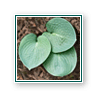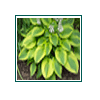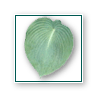-
 Background Hostas
- We have an individual page on every hosta name which
includes all the information in our database that relates to
that name. This includes plants when it is mentioned as being "in the
background" of a hosta cultivar. It also lists plants with
similar names, similar looking hostas and plants described
as a
certain "type" of hosta.
Background Hostas
- We have an individual page on every hosta name which
includes all the information in our database that relates to
that name. This includes plants when it is mentioned as being "in the
background" of a hosta cultivar. It also lists plants with
similar names, similar looking hostas and plants described
as a
certain "type" of hosta.
-
Breeding
Plants - This includes lists of hostas
by the number of offspring they have produced as pod parent,
pollen parent, sport mother or where they are in an earlier
generation.
-
Hosta
Flowers - Data on the various flower
colors, seasons of bloom, fragrant flowers, tepal color
patterns, flower scape colors, flower shapes and anther
colors may be found in this section.
-
 Hosta
Images - Our best digital images have
been rated and listings of the 5-Star pictures are listed in
the database. These hosta images are available for use by
others by following our
Image Use Policy.
Note: Of course
this only applies to the over 4,000 pictures from our own collection and
does not include any of the over 2,000 images donated by others
for display on The Hosta Helper.
Hosta
Images - Our best digital images have
been rated and listings of the 5-Star pictures are listed in
the database. These hosta images are available for use by
others by following our
Image Use Policy.
Note: Of course
this only applies to the over 4,000 pictures from our own collection and
does not include any of the over 2,000 images donated by others
for display on The Hosta Helper.
-
Hosta Leaf Traits -
Hostas shown here are listed by their base leaf color, type
of variegation, seasonal color changes, leaf shapes, petiole
traits, blade contours, surface reflectivity, leaf tips and
leaf vein depth.
-
Hosta
Originators - We have lists of people or
organizations which have developed new hosta cultivars
through hybridizing, sports or selection. This includes
tables showing the top originators by the number of new
cultivars they have introduced. Information is also
organized by Alphabetical Order, U.S. State or Country.
-
 Hosta
Parents - As the name implies, this is a
series of pages showing the number of offspring associated
with a particular species or cultivar. There are also pages
that show the names of the offspring for each type of hosta.
Pod parents, pollen parents, sports mothers and, often,
grandparents are listed.
Hosta
Parents - As the name implies, this is a
series of pages showing the number of offspring associated
with a particular species or cultivar. There are also pages
that show the names of the offspring for each type of hosta.
Pod parents, pollen parents, sports mothers and, often,
grandparents are listed.
-
Hosta Plant Traits -
These are traits related to the hosta clump ranging from
mature clump size, growth rate, plant form, genetic ploidy
and clump texture.
-
Hosta
Problems - Although hostas are generally low
maintenance plants, there are a few physiological problems
that are associated with certain species or cultivars. We
have listings of cultivars known to emerge early and are
susceptible to frost damage. Others suffer from spring
desiccation on their leaves or exhibit the drawstring
effect. Some hostas are noted as being attractive to slugs
while others are resistant to them.
-
Hosta Seeds
- Certain hostas routinely set viable side, some set
non-viable seed and others don't set seeds at all. Cultivars
may be produced through open-pollination, self-pollination
or have unknown parentage. Most hosta produce seeds in pods
the same color as the foliage while some have red or purple
seed pods.
-
Hosta
Species - Currently there are considered to
be 42 species of hostas. We have listings of where species
acted as pod parent, pollen parent or species mother of
named cultivars.
-
 Name Word
Searches - For a bit of fun, we have pulled
together many database pages based on words used in the
names of hosta cultivars. In some cases, you can open a
table that shows all the hostas that have Hadspen, Golden,
Summer or Halo in their name for instance. We also have
gathered together names that relate to a certain topic such
as weather, geography, sports, the arts and many, many
others.
Name Word
Searches - For a bit of fun, we have pulled
together many database pages based on words used in the
names of hosta cultivars. In some cases, you can open a
table that shows all the hostas that have Hadspen, Golden,
Summer or Halo in their name for instance. We also have
gathered together names that relate to a certain topic such
as weather, geography, sports, the arts and many, many
others.
-
Propagation - This includes listings of all
the cultivars and offspring by pod parent, pollen parent and
sport mother. There also tables showing plants that were the
result of chemical treatment during hybridization.
-
Registered Hostas - Named hostas should all
be registered with The American Hosta Society to avoid
confusion in the gardening public. This provides a system
for properly identifying the specific traits of a hosta by a
particular name. Our retrieval pages sort hostas by cultivar
name, year of registration or non-registered status.
-
 Selecting Hostas - When trying to figure out
which hostas to grow in an ornamental garden, there are many
factors to consider. Hostas generally fill a landscape
design niche in the areas of plant size, leaf color and
clump texture. We have developed data pages to show
cultivars in a wide range of size and color combinations to
help in your choices. Also included are recommendations and
awards by a wide range of sources from the Hosta of the
Year, Popularity Poll by The American Hosta Society and
others.
Selecting Hostas - When trying to figure out
which hostas to grow in an ornamental garden, there are many
factors to consider. Hostas generally fill a landscape
design niche in the areas of plant size, leaf color and
clump texture. We have developed data pages to show
cultivars in a wide range of size and color combinations to
help in your choices. Also included are recommendations and
awards by a wide range of sources from the Hosta of the
Year, Popularity Poll by The American Hosta Society and
others.
-
"Type"
Hostas - Often seasoned hostaphiles will say,
"Oh, that looks like a 'Sieboldiana' type hosta". They
might point out how similar looking two plants are or that
two plants with different names are actually the same plant.



